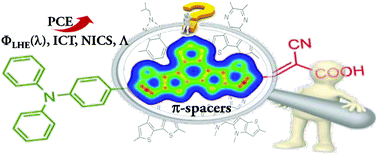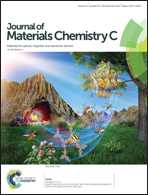Rigid fused π-spacers in D–π–A type molecules for dye-sensitized solar cells: a computational investigation†
Abstract
A class of D–π–A dyes with rigid fused π-bridges comprising electron rich and deficient segments has been investigated by means of quantum chemical calculations. To gain a better understanding of the effects of these rigid spacers on the photophysical properties and the cell performances, the geometries, electronic structures, and absorption spectra of the dyes and dye–TiO2 complexes, and the relevant physical parameters in relation to the short-circuit photocurrent density and the open-circuit photovoltage are analyzed in detail to establish structure–property relationships. The calculated results indicate that the π-bridges containing both the electron-deficient moiety and electron-rich moiety could improve light-absorbing capacities, modulate the levels of frontier orbitals, facilitate intramolecular electron delocalization by decreasing the aromaticity of the π-system and destroying the coherence in possible multiple electron transfer pathways, and enhance charge injection at the dye/TiO2 interface. Such combination of molecular components with different electronic characters provides an effective approach to design novel π-bridges and shed light on the development of high-performance dyes.



 Please wait while we load your content...
Please wait while we load your content...